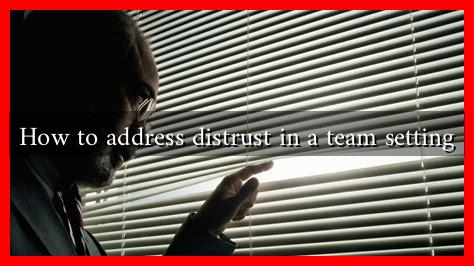-
Table of Contents
- How to Address Distrust in a Team Setting
- Understanding the Roots of Distrust
- Strategies to Build Trust in Teams
- 1. Foster Open Communication
- 2. Clarify Roles and Responsibilities
- 3. Promote Team-Building Activities
- 4. Lead by Example
- 5. Address Conflicts Promptly
- Case Study: The Impact of Trust on Team Performance
- Statistics on Trust in Teams
- Conclusion: Building a Trustworthy Team Environment
How to Address Distrust in a Team Setting
Trust is the cornerstone of any successful team. When team members trust one another, collaboration flourishes, communication improves, and productivity soars. However, distrust can creep in for various reasons, leading to a toxic work environment. This article explores effective strategies to address distrust in a team setting, fostering a culture of openness and collaboration.
Understanding the Roots of Distrust
Before addressing distrust, it’s essential to understand its origins. Distrust can stem from various factors, including:
- Lack of Communication: Poor communication can lead to misunderstandings and assumptions that breed distrust.
- Past Experiences: Previous negative experiences with team members can create a barrier to trust.
- Unclear Roles and Responsibilities: When team members are unsure of their roles, it can lead to confusion and conflict.
- Competition Over Collaboration: A competitive atmosphere can foster distrust, as team members may feel threatened by one another.
Strategies to Build Trust in Teams
Addressing distrust requires a proactive approach. Here are several strategies that can help rebuild trust within a team:
1. Foster Open Communication
Encouraging open dialogue is crucial in rebuilding trust. Team members should feel safe expressing their thoughts and concerns. Consider implementing regular check-ins or feedback sessions where everyone can voice their opinions without fear of retribution.
2. Clarify Roles and Responsibilities
Clearly defining roles and responsibilities can eliminate confusion and reduce conflict. When team members understand their individual contributions to the team’s goals, they are more likely to collaborate effectively.
3. Promote Team-Building Activities
Engaging in team-building exercises can help strengthen relationships among team members. Activities that require collaboration can break down barriers and foster a sense of camaraderie. For example, a study by the University of Central Florida found that team-building activities can significantly improve team cohesion and trust.
4. Lead by Example
Leadership plays a vital role in establishing trust within a team. Leaders should model trustworthy behavior by being transparent, accountable, and approachable. When leaders demonstrate trustworthiness, team members are more likely to follow suit.
5. Address Conflicts Promptly
Ignoring conflicts can exacerbate distrust. It’s essential to address issues as they arise, facilitating open discussions to resolve misunderstandings. Conflict resolution training can also equip team members with the skills needed to handle disputes constructively.
Case Study: The Impact of Trust on Team Performance
A notable example of the importance of trust in a team setting can be seen in the case of Google’s Project Aristotle. This initiative aimed to identify the key factors that contribute to effective teams. The research revealed that psychological safety—where team members feel safe to take risks and be vulnerable—was the most significant factor in team success. Teams that fostered trust and open communication outperformed those that did not.
Statistics on Trust in Teams
According to a study by the American Psychological Association, teams with high levels of trust are 50% more productive than those with low trust levels. Furthermore, organizations with high trust levels report 74% less stress among employees, leading to improved overall well-being and job satisfaction.
Conclusion: Building a Trustworthy Team Environment
Addressing distrust in a team setting is not an overnight process, but it is essential for fostering a productive and harmonious work environment. By promoting open communication, clarifying roles, engaging in team-building activities, leading by example, and addressing conflicts promptly, teams can rebuild trust and enhance collaboration.
In summary, trust is a vital component of team dynamics. By implementing these strategies, organizations can create a culture of trust that not only improves team performance but also contributes to employee satisfaction and retention. For further reading on building trust in teams, consider exploring resources from the American Psychological Association.

